- Vanquish 65
- Mini Maniac
- RG65 Appendages
- Maniac MK II
- IOM Appendages
- Marblehead Class
- Marblehead Appendages
- RT65 Ragnarok
- RT65R Armageddon
- RC65 Adrenaline
- ST65 Sowelu
- Mini40 / F48 Class
- Nightmare X
- Nightmare MK VIII
- MultiOne Class
- FireDragon 1000
- DIY Sail Winch
- Rig Building
Rig building
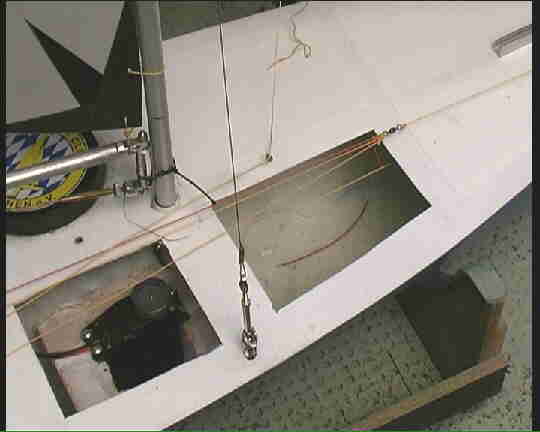


RC Sailboat Rigging Setup- Briefed in 17 Easy Steps
Table of Contents
Introduction
To build a model sailboat, you’ll need a lot of time, patience, and talent. Remote control sailboat beginners should start by altering or fixing a pre-existing model. It is possible to create a quicker and more sophisticated sailboat by rigging an existing model.
What to do for the rc sailboat rigging setup ?
Tether the retaining bolt and wire mainsail luff. Insert the mast stub and slide the entire main boom assembly. Push the masthead and backstay crane. Adjust the sail to match the mast reinforcement ring. Attach the eye in the mainsail clew. Close the hooks. Set the backstay’s length to the right.
To get the overall understanding, read the entire article.
Things to Bring
- Stitching Device
- Sailboat Controlled via Remote
- Thread Made From Polyester
- Fisherman’s Spectra Line
- Dacron Sails
- Utility knife
Procedure for Rigging
Use these rigging guidelines to their full extent. This ensures that the boat will sail with the qualities and performance that its creators intended. You can also check the RC dirt oval setup guide to ease your work.
Step 1: Replace Old Sails
Remove and replace the old sails. Cut out the new main and headsails from Dacron. Measure the old ones from the model and add a half-inch on each side to the new measurements. Tether the retaining bolt.
Step 2: Wire Mainsail with Eyelets
All six eyelets on the mainsail luff should have wired mainsail luff rings attached to them.
Step 3: Place the Mast Stab
Be careful not to get the plastic collar’s bevelled edge. Insert the mast stub into the bottom of the mast.
Step 4: Slide Main Boom
From the bottom, slide the entire main boom assembly onto the mast stub.
Step 5: Slide Rings Under the Mast
Starting at the luff of the mainsail, slide all rings beneath the mast one at a time.
Step 6: Assemble Plug
Push the masthead and backstay crane. Assemble the plug into the mast. Cut a 250mm Dyneema length and tie the mainsail’s head to the backstay crane.
Step 7: Layout the Sail
Adjust the sail to match the mast reinforcement ring at its highest point. The sail’s head may readily swivel. Poles are sheeted out at an angle of 80 degrees when the boat’s sailing with the breeze.
Step 8: Attach the Cunningham
Attach the Cunningham (downhaul) as demonstrated by cutting a 300mm length of Dyneema. Tie a cord to the eye in the gooseneck fitting’s uppermost eye.
Step 9: Tie Bowsie’s Eye
Follow this path: First, tie one end to a Bowsie’s eye. Then, tie a second Bowsie’s eye; finally, tie a third Bowsie’s eye.
Step 10: Attach the Mainsail Clew
Attach the eye in the mainsail clew (bottom right corner) to the mainsail clew using a line.
Step 11: Close the Hook
Close the hook’s open end with thin-nosed pliers. Keep your sail from falling off while you’re out on the water.
Step 12: Replace the Sail If Needed
If you need to replace the sail, simply use a flat-bladed screwdriver to pry it open once again.
Step 13: Cut Dyneema
For the Backstay, cut a 900mm length of Dyneema. The Backstay Crane’s end hole has a loop where you can tie a piece of string.
It’s time to attach one of our 6mm stainless steel rings to its bottom end. Using a Mast Socket, insert the mast and the rigged Mainsail into the hull.
Step 14: Attach the Loop
Once you’ve cut a 500mm piece of Dyneema, tie a loop in one end. Weave the other end through the first small gaps in a Bowsie. Then throw the rim at the bottom of the Backstay.
Finish it back at the Bowsie. Using a metal hook in the Transom (rear edge of the hull), attach the loop to the backstay. Then put the Bowsie nearly halfway along the bottom rope and secure it.
Step 15: Tighten the Leech
To allow the leech (back edge) of the main to twist a little, lightly tighten the compression strut. Such that the leech (back edge) is under mild tension. Adjust the Cunnigham such that the luff of the sail is just slightly strained.
Step 16: Adjust the Position of the Rings
Set the backstay’s length to the right. A spacing of roughly 25 millimetres between the boom tube’s centre. Achieve the sail foot midway by adjusting the position of the silicon rings (SR5) and the mainsail clew hook.
Step 17: Connect the Foresail
Use the spectra fishing line to loop between the grommet and the eyebolt. Connect the foresail to the top of the mast before the mainsail.
To make use of the foresail, equip the boat’s bow with a second, shorter boom. Connect the sail’s grommets to the short boom’s front and back eye bolts with spectra lines.
You can check these suggested rigging tools. You need these tools for rigging setup-
| Product 1 | |
| Product 2 |
Apply a few drops of thin CA adhesive into the Dyneema cord at the point of the cut. Then cut through it at an angle. The cut end will be firm and pointed, making it simple to weave through the Bowsies.
A dollop of thin CA adhesive applied to the knot can help keep it in place. Once you’ve tied it, trim any extra rope.
Don’t use hot gun glue as it doesn’t stick to this type of surface. If you take the time to secure all knots now, you’ll have a long-term reliable vessel.
Tips for Better Setup
A Dacron sleeve should be added where the lines come into contact with the hulls or plastic parts. Because Spectra is extremely powerful and can shred into the material.
Ask sailmakers for scraps or old, ripped sails that you may use to build the remote control boat sails. Only if they are willing to part with them.
There are a few things to keep in mind when it comes to rigging more sophisticated rigs. Like double mast designs or using spinnakers until you’ve gained some experience in the activity. Always clean your RC boat as you clean your RC car to avoid rusting.
How tight should the rigging on a sailboat be?
If you push or tug on them, they shouldn’t wiggle about too much. So make sure they’re snug. Tighten them up if they’re still slack or floppy.There is no need to tighten any of the other shrouds after the cap shrouds are in place. Because they follow in consecutive order.
What’s the simplest way to sail a boat?
The Lateen Rig is a great starting sailboat. It only requires 2 ropes in its basic form.The Lateen Rig is one of the most basic sailing rigs. A spar, boom, and mast are all part of this rig. As are a single jib sheet and mainsheet.
How much does it take to replace a sailboat’s rigging?
Re-rigging a sailboat can cost anything from $1,000 to $5,000. Re-rigging a 40-foot boat with wire is estimated to cost roughly $100 per foot. Which includes the round-trip costs of hauling, launching, and unstepping the rig (about $2,500).
Final Words
We’ve discussed here in detail on the rc sailboat rigging setup. This should help with the rigging setup, and we sincerely hope it does.
OK, so the above may look a little daunting. You’ll be able to recall this procedure with ease after completing it five or six times. Be familiar with and comfortable with your tools, settings, and methods.
The very best to you!
Travis Murray
Leave a Comment Cancel reply
Save my name, email, and website in this browser for the next time I comment.
- Gift Certificates
- My Account
- Sign in or Create an account
Currency Displayed in

- Dragon Flite 95
- Hales Micro
- Sail Accessories
- Insignia Sailcloth
- Film by the Foot
- Sailmakers Full Roll
- Special Tools
- MX Components
- Dragon Force RG65

Popular Brands
- Variant Marine Hardware
- Brighton Boat Works
- Jelacic Sails
- View all brands
- View all categories
All prices are in USD .
| |

How to Sail an RC Sailboat – Step by Step Instructions – 5 Minute Read

Affiliate Disclaimer
As an affiliate, we may earn a commission from qualifying purchases. We get commissions for purchases made through links on this website from Amazon, the Ebay Partner Network (EPN) and other third parties.
Sailing an RC sailboat is fun, but it takes some practice before you get good at it. I certainly needed it when I started! If you want to take your interest in RC model boats to another level, then you should consider learning how to sail an RC sailboat.
However, learning how to sail RC sailboats requires patience and perseverance. There are several things that you need to master before you can begin sailing. This article will teach you how to sail a radio-controlled sailboat.
Read on below to discover tips that will avoid failure in learning how to sail model sailboats, that apply to all size boats.
Step by step Instructions
How does a yacht sail, how are the sails and rudder of an rc sailboat moved, moving forward in a straight line, sailing into the wind, sailing away from the wind, final thoughts.
First, here’s a summary step by step approach to learning how to sail an RC sailboat:
- Consider joining a local club ( USA UK ) where you’ll find lots of helpful RC sailors and RC sailing events that will help you learn. You may even be tempted to get into RC sailboat racing.
- In any event, choose a day with a gentle, consistent, light wind, preferably with the wind direction towards you, just in case you lose control of your boat.
- Find a medium-sized lake or pond, and avoid rivers or the sea, where there may be strong undercurrents. A local club will have a safe sailing area. Look out for areas that may have weeds or reeds, or shallows that could strand your boat. Remember to factor in the depth of the keel, which, on most model sailing boats, is significant.
- Check you are able to sail in your chosen area – ie no prohibitions – and keep clear of swimmers, people fishing, full sized boat traffic, and wildlife.
- Avoid days when it’s busy in your sailing area with other modelers until your sailing skills are such that you can feel confident.
- Set up your RC sailboat on its stand, and check the rigging is as it should be according to the boat’s instructions. Ensure you have brought the boat battery pack charger, the batteries are charged, and you have spare AA batteries for transmitter. Turn on the transmitter, and test that the rudder control and sail servos are all working properly.
- Ensure you understand the basics of sailing, set out below, before launching your RC sailboat. Keep a keen eye on how your boat reacts to the wind, and be ready to react in turn by altering the sail angle to maintain the boat speed as far as possible.
The first thing you’ll need to know is how does a yacht sail? An rc sailboat sails just like a full size yacht. The wind energy pushes against the sails and flows over them, creating a difference in wind pressure on each side of the sail, which is translated to forward movement by the keel of the boat. Without the keel, the boat would be pushed in the direction of the wind.
To keep the yacht moving forward, the sail angle to the wind is adjusted depending on the position of the boat. Paradoxically, a sailing boat can sail into the wind, as well as with the wind. The only direction that can’t be sailed is with the wind directly in front.
The direction of the boat is adjusted by the rudder, which is at the back of the boat.
The following diagram shows the sail angles at different points of the wind:
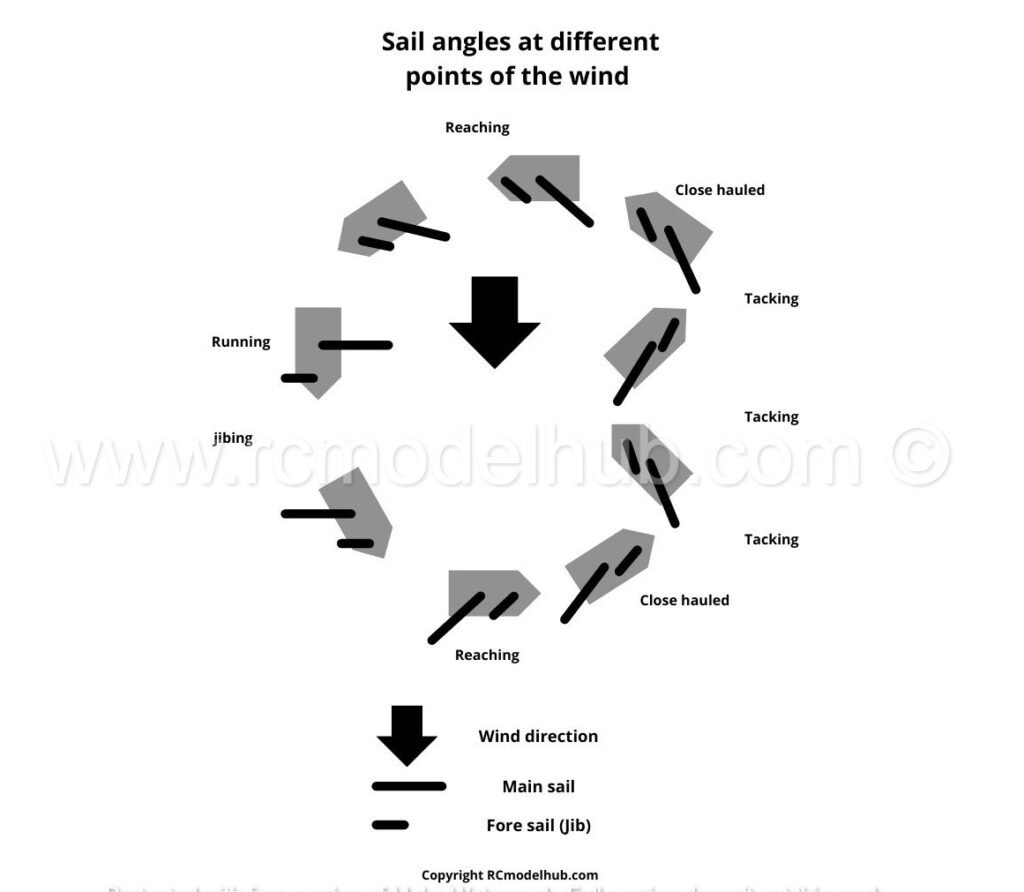
As a beginner RC sailing boat helmsman, many of these terms will be confusing to you, but they will soon become familiar.
The controls of an RC boat are explained in more detail in t his article , but basically, the hull (body) of the boat contains batteries that power servos which in turn move the rudder, the main sail, and the fore sail (the “jib”). The servos are controlled by a receiver, that takes commands from the RC transmitter which you hold in your hand. Here’s a short video that explains the transmitter controls:
How to sail an RC sailing boat
First, the basic skills. With the boat in the water, start with the wind half way between the front (bow) of the boat, and the side (beam). Keeping the rudder straight, trim (move) the sails so that they are close to the hull (close hauled) and the boat should move forward. If the wind is gusty, or very strong, move your transmitter control to let out the sails, spilling the wind, to keep the boat from keeling over.
If you’re sailing into the general wind direction, you’ll need to learn to “tack”, which involves turning the boat from a position where the wind is coming on one side of the bow, through the head-on wind, to end with the wind on its other side. This is achieved by moving the rudder to turn the yacht, whilst changing the angle of the sails to the wind – see the diagram above.
So the boat moves forward via a zig zag course.
As the boat turns into the wind, it slows, so this maneuver should be completed as quickly as possible, otherwise, the boat could get stuck with the sails flapping – this is called being “in irons”.
If the direction you wish to sail in means the wind is behind the boat, it is called running before the wind. In this case, turning the boat involves “jibing”, which is the opposite of tacking.
To change direction whilst running with the wind, move the rudder so the wind goes around the back (stern) of the boat and haul the sails in. As the boat comes round, the wind will move from one side of the sails to the other.
If this is not done smoothly, it could cause the sails to violently move in the opposite direction, possibly causing damage and maybe even capsizing the boat.
So those are the basics of learning how to sail an RC sailboat. As I’ve said above, the best way to refine your skills is to get out on the water and practice.
if you have any interest in remote control sailing but aren’t sure where to begin, use the step-by-step guide above to learn how to sail an RC sailboat. Once you’ve mastered the basics, you can move on to the exciting world of racing sailboats.
If you’re still considering your first RC beginner sailboat, take a look at our article on beginner RC sailboats , or for the more adventurous, consider building your own RC sailboat from a kit. More about that here .
Image credit Nick Kinkaid
About the author
It all started with a line controlled spitfire 50 years ago….
That turned into a life long interest in models, in particular radio controlled models, but I’ve only got back into it since I’ve been retired. As a result a lot has changed, and I’ve been happily starting afresh, researching into the hobby and finding answers to the questions all beginners have when starting out.
I hope you find some answers to the queries you have, and go on to enjoy all aspects of this fascinating hobby.
Latest posts
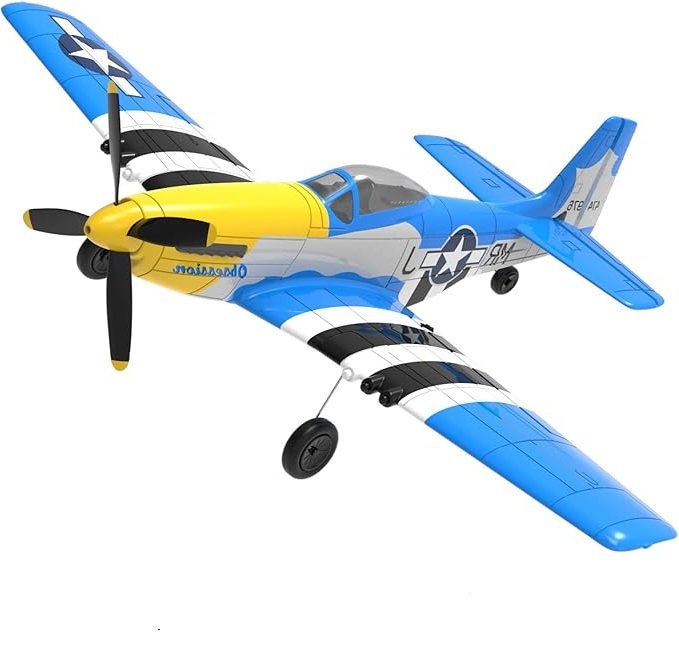
VOLANTEXRC P51 Mustang RC Plane Review: A Beginner’s Dream?
I was thrilled when I discovered the VOLANTEXRC RC Plane. This 4-channel WWII RC Airplane, specifically the P51 Mustang model, is truly a beginner’s dream come true. With its ultra-stable Xpilot gyro stabilizer system and 3-level flight control system, it’s incredibly easy to fly, whether you’re a novice or an experienced flyer. The impressive 2.4…
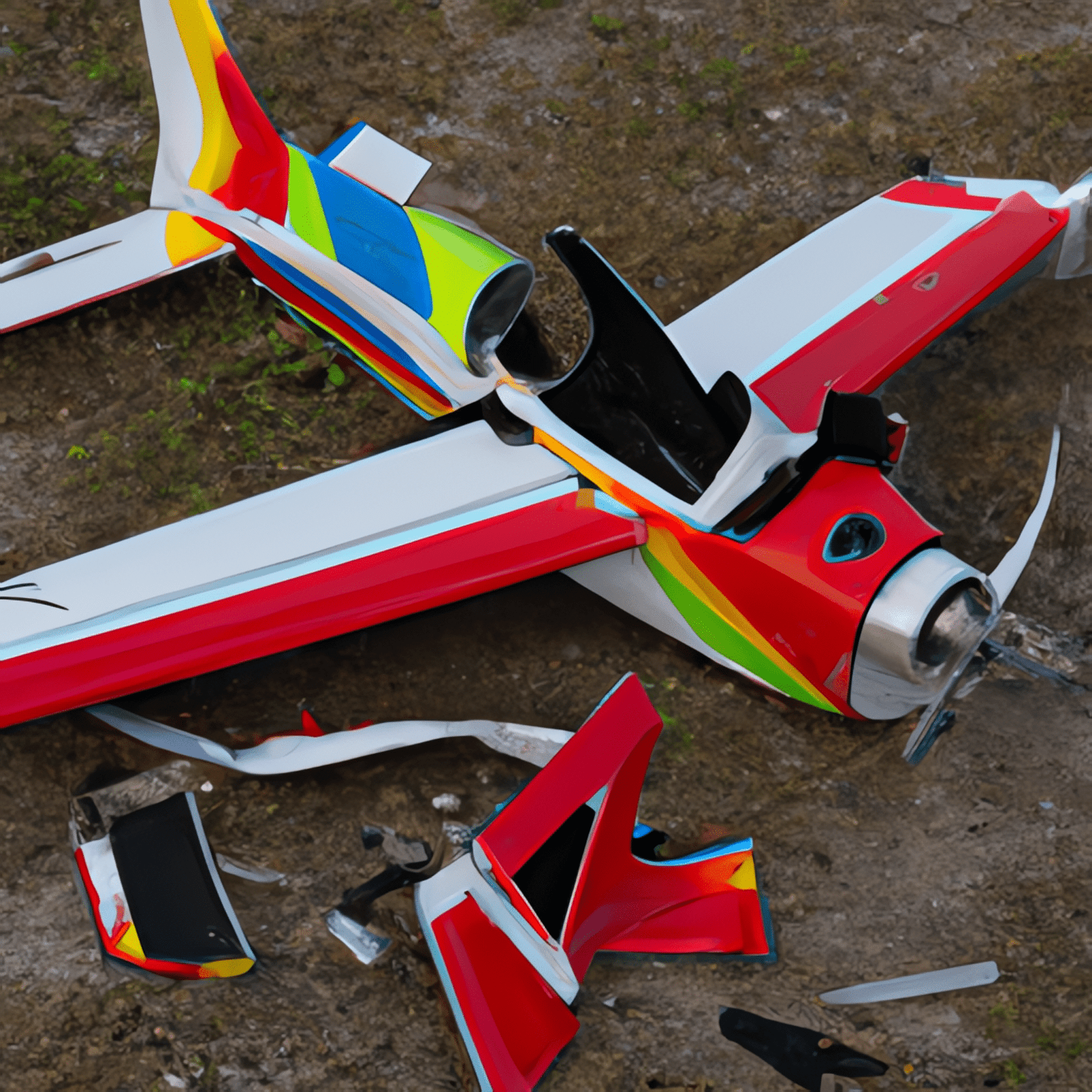
RTF RC planes with SAFE technology: No More Crashes?
RTF RC planes with SAFE technology have revolutionized the world of remote control aviation, offering a new level of ease, control, and safety for both beginners and experienced hobbyists. What a change from my early days of flying RC planes, when you fully expected to come home with your plane in bits! These innovative aircraft…
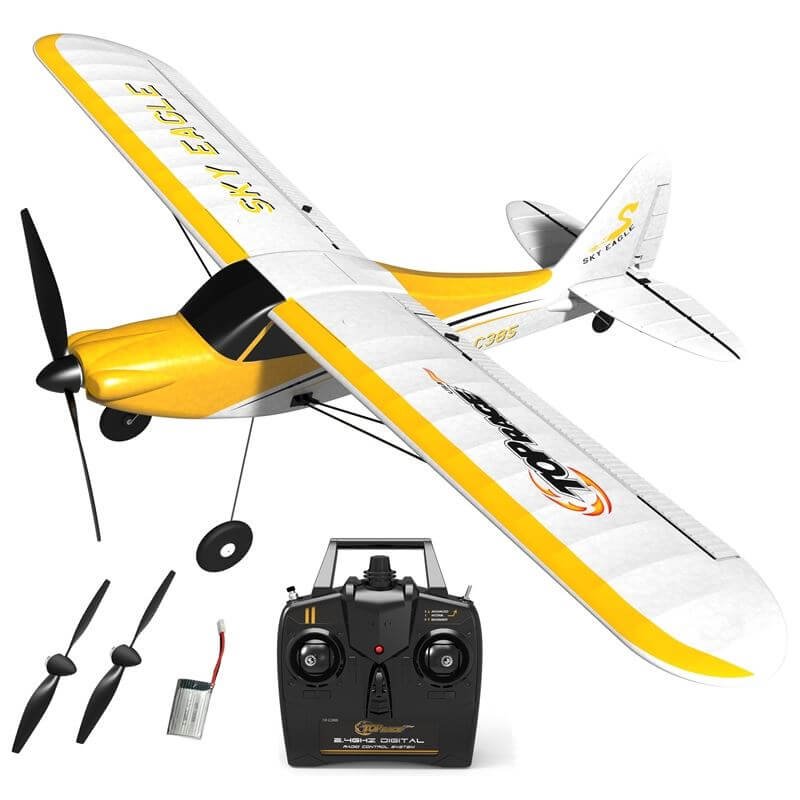
Top Race RC Plane TR-C385 Review: Stunt Flying Delight
I recently had the chance to test out the Top Race 4 Channel RC Plane TR-C385. It surpassed all my expectations. Designed for adults and older kids, this ready-to-fly airplane offers an exhilarating stunt flying experience. With precise control and maneuverability, thanks to its 4-channel system, this RC plane is a great starter or intermediate…

Image Unavailable

- To view this video download Flash Player
Mast Set for the V1-V2 Joysway Dragon Force DF65 RC Sailboat
Purchase options and add-ons
- Original Factory Replacement Part.
- Joysway OEM Replacement Part.
- Fits the V1-V2 Joysway DF65 Dragon Force
Customers also viewed these products

Product information
| Product Dimensions | 1 x 1 x 1 inches |
|---|---|
| Item Weight | 0.95 ounces |
| ASIN | B00DM0TS1M |
| Item model number | 880521 |
| Manufacturer recommended age | 14 - 15 years |
| Customer Reviews | 2.8 out of 5 stars |
| Manufacturer | Venom Group International |
| Date First Available | June 24, 2013 |
Warranty & Support
Product Description
High quality replacement Mast Set for the DF65 Dragon Force RC Sailboat by Joysway.
Looking for specific info?
Customer reviews.
- 5 star 4 star 3 star 2 star 1 star 5 star 27% 0% 0% 73% 0% 27%
- 5 star 4 star 3 star 2 star 1 star 4 star 27% 0% 0% 73% 0% 0%
- 5 star 4 star 3 star 2 star 1 star 3 star 27% 0% 0% 73% 0% 0%
- 5 star 4 star 3 star 2 star 1 star 2 star 27% 0% 0% 73% 0% 73%
- 5 star 4 star 3 star 2 star 1 star 1 star 27% 0% 0% 73% 0% 0%
Customer Reviews, including Product Star Ratings help customers to learn more about the product and decide whether it is the right product for them.
To calculate the overall star rating and percentage breakdown by star, we don’t use a simple average. Instead, our system considers things like how recent a review is and if the reviewer bought the item on Amazon. It also analyzed reviews to verify trustworthiness.
- Sort reviews by Top reviews Most recent Top reviews
Top reviews from the United States
There was a problem filtering reviews right now. please try again later..
- Amazon Newsletter
- About Amazon
- Accessibility
- Sustainability
- Press Center
- Investor Relations
- Amazon Devices
- Amazon Science
- Sell on Amazon
- Sell apps on Amazon
- Supply to Amazon
- Protect & Build Your Brand
- Become an Affiliate
- Become a Delivery Driver
- Start a Package Delivery Business
- Advertise Your Products
- Self-Publish with Us
- Become an Amazon Hub Partner
- › See More Ways to Make Money
- Amazon Visa
- Amazon Store Card
- Amazon Secured Card
- Amazon Business Card
- Shop with Points
- Credit Card Marketplace
- Reload Your Balance
- Amazon Currency Converter
- Your Account
- Your Orders
- Shipping Rates & Policies
- Amazon Prime
- Returns & Replacements
- Manage Your Content and Devices
- Recalls and Product Safety Alerts
- Registry & Gift List
- Conditions of Use
- Privacy Notice
- Consumer Health Data Privacy Disclosure
- Your Ads Privacy Choices

RC Boat Magazine The World's Leading Radio Control Boating Magazine
Sailing 101.
Tony Phalen June 3, 2014 Boating Basics
A Basic Guide to Wind-Powered Boating
SIZE/TRANSPORT NOTES Since RC sail craft are available in many shapes that feature different mast/keel layouts, the beginner will need to first figure-out what size yacht will fit his/her lifestyle. If you have a small vehicle and limited storage space at home, a 20 to 30-inch long hull with an easily detachable mast/sails and a detachable lower keel may best suit your needs. If you choose a larger hull with an equally long mast and keel, it will take-up a lot more vehicle trunk volume; plus, more pre-sail assembly at the lake. Now if your local sailing location has any amount of submerged vegetation, a hull with a shorter-length lower keel will help prevent any weed buildup problems on the underside of the boat. As for the mast/sail layouts available, most kit/RTR boats use a two-piece mast to ease transport and the lower keel mounts in a recess in the hull bottom and it’s retained by a single thumb nut on the deck of the hull.
KIT VS. RTR Until recently the only way to start out in RC sailing would involve building a kit boat made-up from either a wood, fiberglass or molded plastic hull. Today both plastic and fiberglass RTR yachts are commonplace; so, you can now choose between constructing your first sail craft from a kit or by going with an almost-ready-to-run sailboat. If you’ve had some previous RC car/aircraft experience and have enough workspace, a sailboat kit from such companies as Victor Model Products, Thunder Tiger, Kyosho and Graupner can be built using regular hobby tools, adhesives and paints. To complete the majority of these kits you’ll only need to roundup a stick-style, two-channel surface radio with two servos, one of which will need to be a high-torque model to control the movement of the jib/main sails on the mast.
In the event you decide to go with a RTR sailboat, Pro Boat, AquaCraft and several of the kit makers listed above all sell preassembled yachts that are suitable for the novice sailor. In most cases, these RTR boats come from their boxes with only the need to install the pre-rigged mast and sails, attach the keel unit and assemble the hull’s support stand. Adding some batteries to the boat’s radio system will finish-up the yacht’s basic buildup as you can then check/trim the rudder and sail movements on the prepped hull. Once rigged at lakeside, you’ll want to make sure that all of the vessel’s mast and sail control lines are properly attached and tensioned as indicated in the owner’s manual. Then make a quick range check of the powered-up radio system to make sure that the sails and rudder run through their full range of motions. At this juncture you can launch your new sailboat and the fun of learning how to use the wind to “power” your hull can begin.
First runs: Depending on the wind’s direction across the water you’ll find that by letting out the sails (moving the left stick on the transmitter upwards) will “catch” the air and this is what’s called running downwind or with the wind. To sail in the opposite direction (towards the wind) you’ll have to steer the hull at an angle to the air which is “tacking” and this technique will have less sail extension than the downwind transmitter stick settings. If you steer the boat’s bow directly into the wind it’ll likely just sit there which is to put the yacht “in irons” and the sailor will have to let the bow swing to one side to again get air in the sails. An important factor to sailing in either wind condition is that you must have enough forward hull speed to maintain the flow of water past the rudder blade as this will allow you to turn the hull whenever needed. It will take some time to master the balance between wind speed, sail settings and hull angles to the wind; but, in only a short time the novice will be able to maneuver his/her yacht no matter which direction the air is moving.
Sail support: Like all RC activities model sailing is more fun with a group of boaters and it’s not hard to locate other sailing enthusiasts that might reside near your home. The American Model Yachting Association’s website features a nice club directory to help you pinpoint and contact fellow sailors in your area and you can also use the site to help look for any yacht hardware or racing rules that apply to your brand boat. Custom sails, servos, etc. are all found in the suppliers listing while the rules guidelines section will tell just what modifications on your hull should you decide to try your hand at sailboat racing. Many current RTR and kitted sailing hulls regularly compete throughout the country and the sport sailor can learn a lot of useful running tips from those who race the very same sail craft as the one bought by the beginner. The adaptability of most RC yachts make them fun because both the sport and competitive sailor alike can upgrade their hull’s setup to improve the boat’s on water performance and do it for only a small outlay from their RC budget.
SAIL POINTS • Always apply a drop of CA glue to each rigging cord knot to prevent any mast/sail spillage in breezy conditions.
• When rigging the hull lakeside, keep the boat out of direct winds or simply lay it on the grass to avoid a blow over.
• Remember, a setup sailboat doesn’t like to be anywhere near a running ceiling fan.
• Braided fishing line (with the same outside diameter) can be used to repair/replace any mast or sail lines.
• Be sure to take a folding chair to the lake because the average yacht can sail for a minimum of two hours.
• Since most of a sailboat’s weight is in the keel, carrying it by the lower keel will be the most stress-free way to launch/retrieve it at the lake.
LINKS Aquacraft Models aquacraftmodels.com , 217-398-0007 AMYA theamya.org Pro Boat Models proboatmodels.com , 217 352-1913 Thunder Tiger ttamerica.com , 217-398-8970 Victor Model Products victor-model.com , 337 202-1916
- Classifieds
- Remember Me Forgot Password?
- Boats Sailboats Question Where to get material for the mast, sails and rigging
| [/SIZE] , your premier source for R/C Model Sailboat Fittings from around the world. We stock parts from SAILSetc, KDH, RMG, Cap Maquettes, Hales Micro and Blackmagick Sails. Midwest Model Yachting was formed in 2007 when Great Basin Model Yachting decided to retire from the business. | |
| . | |
| is a good example, are traditionally made from "bits and pieces". For your mast, booms and sails, go to your nearest kite shop and get some 6 mm od carbon fibre tube for the mast and 4 mm od for the booms. While you are there, get some lightweight nylon ripstop or "Icarex" fabric for the sails. Your local fishing tackle shop will sell Spectra fishing line which is best for the running and standing rigging as well as various brass/stainless steel swivels, snap links etc. If they have a scuba section, it'll also be a good source for lead for the ballast. If not they may have 1 lb trolling weights. Model airplane silicone thick-walled fuel tubing is good for rigging/boom attachments and R/C servo clevises especially the ball type are perfect for making the gooseneck/vang. Find out more about the class on or PS don't worry about drilling the carbon fibre for the rigging. Use the Spectra line and whip on any fittings on the mast or booms and reinforce by letting a drop of CA wick into it. The GWS Micro 2BB MG servo is highly rated for the sail control. | |
| . | |
| has an excellent selection of parts, including spars. Also has pieces and parts. has very nice pieces the previous two don't stock. | |
| Carbon spars, both pultruded and wrapped, straight and tapered. | |
| Both for material and for carbon tubes. Also doublesided tape, sticky dacron for numbers and class logos, etc. | |
| (Check against RG65 regulations). | |



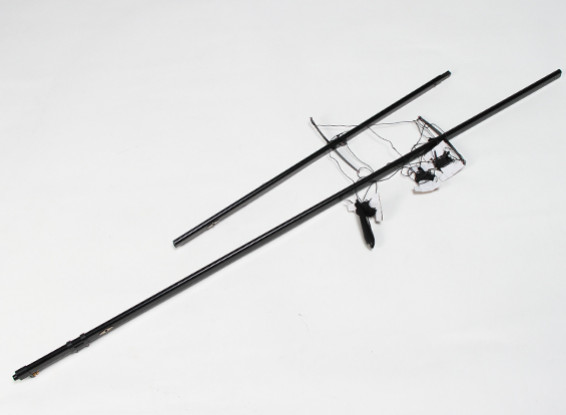



















IMAGES
COMMENTS
Rig Building Tips: IOM class rules don't allow rotating masts and the masts mostly used are without an internal track. The best mast is 12mm or ½" aluminum tube available at local hardware and metal stores. If you want to invest more you can order from RC yachting accessory dealers as well and save maybe 50g with the rig.
Procedure for Rigging. Step 1: Replace Old Sails. Step 2: Wire Mainsail with Eyelets. Step 3: Place the Mast Stab. Step 4: Slide Main Boom. Step 5: Slide Rings Under the Mast. Step 6: Assemble Plug. Step 7: Layout the Sail. Step 8: Attach the Cunningham.
Masts; Sails. Sail Accessories; Sail making Materials. Insignia Sailcloth; Mylar Sailcloth. Film by the Foot; Sailmakers Full Roll; Special Tools; ERC; ... ODOM Class Approved Spiral wound tapered 56.5" Carbon Fiber Mast $69.95 $63.60. Compare. Carbon Fiber 8 mm Pulltruded mast 48" Length $16.00 $14.50. Compare. 11 mm Clear Aluminum Mast $24.44 ...
Explore a wide range of rigs and parts for your RC sailboat, including carbon booms, mast kits, jib boom sets, and more at Sailboat RC.
DF65 C Mast Set Kit
Moving forward in a straight line. First, the basic skills. With the boat in the water, start with the wind half way between the front (bow) of the boat, and the side (beam). Keeping the rudder straight, trim (move) the sails so that they are close to the hull (close hauled) and the boat should move forward.
The more experienced the sail maker gets the better the sails work. This guide is intended to help newbies to cut heir own sails and build their own rigs. Sailmaking Tips: A piece of thin melamine board about 50x200cm is very helpful to loft the outline of the sails. Use packing paper to sketch the outlines according the class rules or a ...
Slack is needed to create an airfoil shape to the sail. 4. Shroud lines (from mast to deck on port and starboard) should have slight tension but not tight like a guitar string. 5. The backstay line should also have minimum tension. (Just enough to keep the mast at a 90 degree vertical.) You may need to use an angled mount for the backstay.
Amazon.com: Mast Set for the V1-V2 Joysway Dragon Force DF65 RC Sailboat : Toys & Games. $2207. FREE delivery Wednesday, February 21. Details. Or fastest delivery Wednesday, February 14. Order within 9 hrs 51 mins.
Smaller than the Vela design, the AquaCraft Paradise sailboat can be taken—apart into three sections—the sail/mast set, the hull itself and the lower keel unit; so, it can fit into even a small hatchback for transport to the lake. ... Since RC sail craft are available in many shapes that feature different mast/keel layouts, the beginner ...
Hi everyone, I am in the process of building a scratch sailboat from a free plan I got online. it's a 65cm plan came from spain and the name of file was alcaravane.pdf. (don't know much more) Anyway I just venture with scratch building it. I am done with the fibreglass hull and the keelbox, I am about to build the mast box but I don't have a mast.
Trading since 1978 SAILSetc is one of the largest suppliers of equipment for radio control sailing. Our range of products is focussed on the four international classes (One Metre, Marblehead, Ten Rater, A Class) as well as the growing number of smaller classes. However, the equipment we supply is also suitable for, or adaptable to, many of the ...
Wooden RC Sailboat Mast. March 25, 2017. In my previous boats, I've always used an aluminum mast (and a carbon fiber one on the Tippecanoe T37). For this Vintage Marblehead High Flyer Sun Wind II though, in keeping with the tradition of the 1940's/1950's, I thought it would be fun to attempt a wooden mast. This is my first try!
RC Sailboat Phantom-1.89m - Mast Set. Display :All categories 0 Vehicles1192Boats135Parts & Hardware68. RC Sailboat Phantom-1.89m - Mast Set. You will earn 13 bonus points for buying this item. RC Sailboat Phantom-1.89m - Mast Set. 0 Reviews. Price: Now savesave$0.00 $0.00. $16.76.
There are 7 common components that are found on nearly all RC Sailboats. The 7 common parts consist of the hull, mainsail, mast, boom, jib, keel and rudder. The hull is the main structure of the boat that contains all the other parts within it. Typically found in the center of an RC Sailboat on the under side of the hull is the keel.
IOM Mast "A", "B", "C" (No.1, No.2, No.3) | Sailboat RC. IOM mast perbended with Sailboat RC technology. We use our own measurements to get the best performance for your IOM yacht.
For larger RC sailboats a rechargeable battery is a requirement. The average user would use a 4.8-6.0v NiMh pack however LiFE, Li-ion, LiPo packs are available but be certain to include a Voltage Regulator in your system to limit the voltage. Sail Servo - RC Sailboat Controls. The most important servo for an RC Sailboat is of course the Sail ...
When the wind pushes the boat onto its side, the weight of the keel counteracts the lean and pushes the boat back level. ... According to Perini's website Bayesian has a 75m (246ft) mast which it ...
Do anybody knows dimensions of halyard sheaves on the top of the Mast in O'Day32? I mean diameter and width. Menu Menu. Log in. Register. Menu Home. Forums. New ... New media New comments. Boat Info. Downloads Weekly Quiz Topic FAQ 10000boatnames.com. Classifieds. Sell Your Boat Used Gear for Sale. Parts. General Marine Parts Hunter Beneteau ...
The MoSCoW method is a prioritization technique used in management, business analysis, project management, and software development to reach a common understanding with stakeholders on the importance they place on the delivery of each requirement; it is also known as MoSCoW prioritization or MoSCoW analysis.. The term MOSCOW itself is an acronym derived from the first letter of each of four ...
Browse 309 professional two masted sailboat stock photos, images & pictures available royalty-free. St. Petersburg, Russia, February 10, 2024. A two-masted sailing schooner at a winter mooring in the city center. View of two yachts competing in team sailing.August 3, 2024. Belarus, Zaslavskoye Reservoir.
The data set is resumed on 11th June 1908 when the tide gauge was repositioned in French Creek; according to a report of the superintending Civil Engineer at the Dockyard in Malta to the Rear Admiral, referring to a bundle of tidal records for the year 1921, the tide gauge instrument was fitted near the Boat House at the Head of French Creek.
The MoSCoW method is a simple and highly useful approach that enables you to prioritize project tasks as critical and non-critical. MoSCoW stands for: Must - These are tasks that you must complete for the project to be considered a success. Should - These are critical activities that are less urgent than Must tasks.